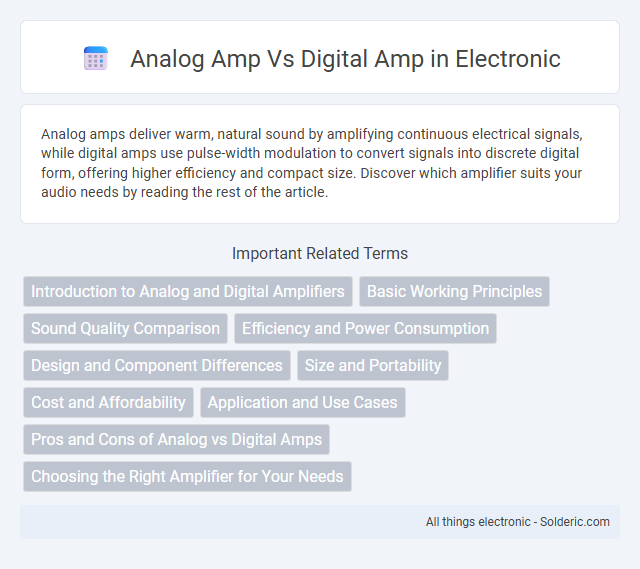Analog amps deliver warm, natural sound by amplifying continuous electrical signals, while digital amps use pulse-width modulation to convert signals into discrete digital form, offering higher efficiency and compact size. Discover which amplifier suits your audio needs by reading the rest of the article.
Comparison Table
| Feature | Analog Amplifier | Digital Amplifier |
|---|---|---|
| Technology | Continuous analog signal processing | Pulse-width modulation and digital signal processing |
| Efficiency | Low (around 50-70%) | High (up to 90% or more) |
| Heat Generation | High due to power loss | Low, energy efficient |
| Sound Quality | Warm, natural sound with harmonic distortion | Clear, precise sound with lower distortion |
| Size & Weight | Larger and heavier components | Compact and lightweight design |
| Cost | Generally lower cost | Typically higher cost |
| Complexity | Simple circuitry | Complex digital processing and design |
| Applications | Hi-Fi audio, vintage equipment | Modern audio devices, portable systems |
Introduction to Analog and Digital Amplifiers
Analog amplifiers use continuous voltage signals to amplify audio waves, preserving the natural warmth and subtle nuances of sound. Digital amplifiers, also known as Class D amplifiers, convert audio signals into digital pulses, offering higher energy efficiency and reduced heat generation. The choice between analog and digital amplifiers depends on factors such as sound quality preference, power consumption, and application requirements.
Basic Working Principles
Analog amplifiers operate by continuously amplifying the input signal through linear circuits, preserving the waveform's original shape and producing a proportional output voltage or current. Digital amplifiers, also known as Class D amps, convert the input signal into a pulse-width modulated (PWM) digital signal, switching transistors on and off at high frequencies to recreate the amplified audio signal efficiently. The fundamental difference lies in analog amps relying on analog signal manipulation, while digital amps utilize digital signal processing and switching techniques for amplification.
Sound Quality Comparison
Analog amplifiers deliver warm, natural sound with rich harmonics and smooth tonal transitions, favored by audiophiles for their authentic audio reproduction. Digital amplifiers provide high efficiency and precise sound control, often exhibiting cleaner output with less distortion but sometimes lacking the analog warmth. The choice depends on preference for organic sound character versus technical clarity and power efficiency.
Efficiency and Power Consumption
Digital amplifiers offer significantly higher efficiency and lower power consumption compared to analog amplifiers, often exceeding 90% efficiency by utilizing pulse-width modulation techniques. Analog amplifiers, typically Class A or AB designs, dissipate more heat due to continuous current flow, resulting in efficiencies around 20-70%. Choosing a digital amp can reduce energy costs and heat generation, making it ideal for power-sensitive applications and improving the overall lifespan of your audio equipment.
Design and Component Differences
Analog amps rely on traditional electronic components like transistors and capacitors to amplify audio signals with continuous waveforms, producing rich, warm sound characteristics favored by audiophiles. Digital amps, or Class D amplifiers, use pulse-width modulation and microprocessors to efficiently convert signals into discrete pulses, resulting in compact designs with lower heat dissipation and higher energy efficiency. Your choice between analog and digital amps depends on whether you prioritize classic sound quality or modern technological performance and energy savings.
Size and Portability
Analog amplifiers typically have larger, heavier components due to traditional circuitry, which can limit portability compared to digital amplifiers. Digital amps use compact, efficient designs with fewer bulky parts, resulting in smaller sizes and enhanced portability. Your choice depends on whether you prioritize the classic sound quality of analog or the convenience and lightweight nature of digital amps.
Cost and Affordability
Analog amplifiers typically offer lower initial costs due to simpler circuitry and widespread availability, making them more affordable for budget-conscious users. Digital amplifiers, while often pricier upfront because of advanced components and improved efficiency, can deliver greater power output and energy savings that reduce long-term expenses. Your choice should balance immediate affordability against potential savings on energy bills and performance benefits.
Application and Use Cases
Analog amplifiers are preferred in high-fidelity audio systems and musical instrument amplification for their warm sound quality and natural signal reproduction. Digital amplifiers, or Class D amps, dominate in portable electronics, home theater systems, and car audio due to their energy efficiency, compact size, and lower heat dissipation. Professional audio equipment often integrates both types to balance sound quality with power efficiency based on specific performance needs.
Pros and Cons of Analog vs Digital Amps
Analog amps deliver warm, natural sound with simple circuitry and lower latency, making them ideal for purists and live performances, but they tend to be bulkier and less energy-efficient. Digital amps offer high efficiency, compact size, and advanced features like digital signal processing, yet they may introduce slight latency and a colder sound profile that some audiophiles find less appealing. Your choice depends on whether you prioritize sound authenticity and minimal distortion or power efficiency and versatile functionality.
Choosing the Right Amplifier for Your Needs
Analog amplifiers deliver warm, natural sound with minimal latency, ideal for audiophiles seeking classic audio quality, while digital amplifiers offer higher efficiency, compact size, and advanced features suited for modern setups. Your choice depends on whether you prioritize sound purity and vintage tonal characteristics or energy efficiency and versatile connectivity options. Understanding your specific requirements helps ensure the amplifier complements your audio system's performance and listening environment.
analog amp vs digital amp Infographic

 solderic.com
solderic.com